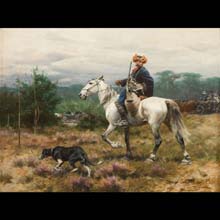
material: oil on canvas
dimensions: 45 × 60,4 cm
description: Hunting scenes enjoyed enormous popularity in the second half of the 19th century. Numerous Polish Munich artists devoted their works to this subject, among others, Maksymilian Gierymski, Józef Chełmoński, Alfred Wierusz-Kowalski and Julian Fałat. The hunting ritual became an important custom of the gentry, associated with the attachment to tradition and regarded as a semblance of the ethos of chivalry. Moreover, hunting trips held a special place in the social life of the Polish aristocracy and landed gentry. The hunting motif first appeared in the works of Józef Brandt in the early 1880s. It was a bloodless world without brutality: the artist concentrated on portraying the colourful tradition, the courage of hunters, the beauty of animals – especially horses and dogs – and the wilderness. Fox-Hunting depicts a hunter mounted on a grey horse, accompanied by a hound. The autumn landscape is dominated by a meadow with tufts of heather. On the left, the composition is enclosed by a pine grove. The characteristic blurring, sketchy, as if dancing brushstrokes and a diverse texture are an evidence that the artist used a photograph while painting this work. A lightened palette results from an attempt at the superficial adoption of the achievements of Impressionism. Aleksandra Krypczyk
exposition: The Gallery of 19th Century Polish Art in Sukiennice,
The Cloth Hall, 1, Main Market Square
key: Realism, polish impressionism, beginnings of symbolism >>>
dimensions: 45 × 60,4 cm
description: Hunting scenes enjoyed enormous popularity in the second half of the 19th century. Numerous Polish Munich artists devoted their works to this subject, among others, Maksymilian Gierymski, Józef Chełmoński, Alfred Wierusz-Kowalski and Julian Fałat. The hunting ritual became an important custom of the gentry, associated with the attachment to tradition and regarded as a semblance of the ethos of chivalry. Moreover, hunting trips held a special place in the social life of the Polish aristocracy and landed gentry. The hunting motif first appeared in the works of Józef Brandt in the early 1880s. It was a bloodless world without brutality: the artist concentrated on portraying the colourful tradition, the courage of hunters, the beauty of animals – especially horses and dogs – and the wilderness. Fox-Hunting depicts a hunter mounted on a grey horse, accompanied by a hound. The autumn landscape is dominated by a meadow with tufts of heather. On the left, the composition is enclosed by a pine grove. The characteristic blurring, sketchy, as if dancing brushstrokes and a diverse texture are an evidence that the artist used a photograph while painting this work. A lightened palette results from an attempt at the superficial adoption of the achievements of Impressionism. Aleksandra Krypczyk
exposition: The Gallery of 19th Century Polish Art in Sukiennice,
The Cloth Hall, 1, Main Market Square
key: Realism, polish impressionism, beginnings of symbolism >>>












